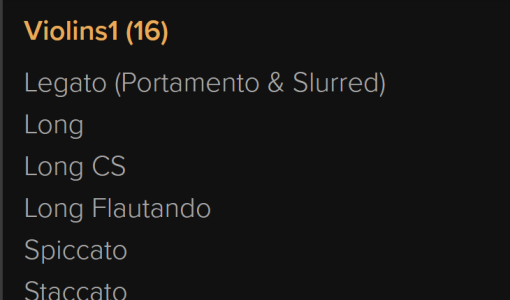You are using an out of date browser. It may not display this or other websites correctly.
You should upgrade or use an alternative browser.
You should upgrade or use an alternative browser.
String libraries section sizes
- Thread starter Vik
- Start date
Francisco Relaño Peña
Active Member
When I saw this I was like Oh! Oh! let me go look at
Spitfire Hans Zimmer Strings
(60,20,60,24) or (20,20,20,24)
yeahhhh bwoy hahahah BOOOOM

Maybe too simple question :
If you layer two separate studio size libraries (let's say Cinematic Strings 2 + CSS); can we get a bigger sound which will sound like a symphony sized library?
If yes, what kind of tricks do you do to make the sound fuller and bigger? such as mixing, reverb etc.
If you layer two separate studio size libraries (let's say Cinematic Strings 2 + CSS); can we get a bigger sound which will sound like a symphony sized library?
If yes, what kind of tricks do you do to make the sound fuller and bigger? such as mixing, reverb etc.
jbuhler
Senior Member
It depends on how you mix and the math of mixing and stacking samples is not the math of adding players to a room.Maybe too simple question :
If you layer two separate studio size libraries (let's say Cinematic Strings 2 + CSS); can we get a bigger sound which will sound like a symphony sized library?
If yes, what kind of tricks do you do to make the sound fuller and bigger? such as mixing, reverb etc.
ScarletJerry
Senior Member
I think BBCSO has 16 first violins, not 6.My list is all Spitfire (some of which you may already have so apologies in advance). Grouped by recording location
AIR LYNDHURST HALL:
Appasionata (30 piece) medium-sized chamber section (8,6,6,6,4), legato library, individual sections
Chamber Strings (16 piece) small-sized chamber section (4,3,3,3,3), individual sections, (also an ensemble patch)
Albion One (68 piece) (18,16,14,12,8), ensemble
Originals Epic Strings (60 piece), large string section (16,14,12,10,8), ensemble
Originals Intimate Strings (25 piece) chamber section (8,6,4,4,3), ensemble
Originals Cinematic Frozen Strings (8 piece) small string band (2,2,0,2,2) - no violas, ensemble
Fractured Strings (8 piece) small string band, (4 Violin, 4 Celli, Solo Violin, Solo Cello), ensemble
Symphonic Motions (34 piece), 22 violins & 12 cellos (22,0,0,12,0), ensemble
Symphonic Strings (60 piece), large string section (16,14,12,10,8)
AIR STUDIO 1:
Studio Strings Pro (56 piece), large string section (16.12.12.12.4) and divisi for smaller chamber sections e.g. violins1 can be 16 but also 8 and/or 4a and/or 4b (smallest section possible would be 4,3,3,3,4)
Studio Strings (30 piece), medium-sized chamber section (8.6.6.6.4)
AIR EDEL STUDIOS:
Fragile String Evolutions (15 piece), small-sized chamber section (4,3,3,3,1), long evolving note ensemble
MAIDA VALE:
BBCSO Pro (60 piece) individual sections (6,14,12,10,8), also solo instruments
ABBEY ROAD 1:
AR1 Orchestral foundations (60 piece), high strings are 16,14,12 and low strings are 10,8, ensemble
AR1 Legendary Low Strings (0,0,0,10,8) in octaves, ensemble
AR1 Soaring High Strings (16,14,0,0,0) in unison, ensemble
It depends on how you mix and the math of mixing and stacking samples is not the math of adding players to a room.
So what is a proposed mixing strategy to make 2 bundles sound like symphony sized as realistic as possible?
jbuhler
Senior Member
I don't have either CSS or CS2 and I'm not at all an expert mixer, so take everything with several grains of salt. If I recall correctly, CS2 is the larger ensemble, and already close to symphonic in size. The first thing I would do is work to maximize the impression of size; adding reverb, delay, more distant mics, etc. Then I'd add CSS to it so that it adds the impression of detail but doesn't diminish the impression of size for CS2. You should be left with the impression of CS2+. It almost certainly won't sound like CS2+CSS, but more like: somewhat larger than CS2. (And you generally want to avoid it sounding mostly like a blurring of CS2 and CSS.) You have to be careful though because if you push too much CSS then the mix will move towards CSS in size. It's interesting to hear how this happens (you can especially hear the effect if you mix a solo instrument with a section and hear the impression of the ensemble size diminish as you mix more toward the solo instrument.So what is a proposed mixing strategy to make 2 bundles sound like symphony sized as realistic as possible?
Then, too, while 1+1 often distressingly yields 2 with recording (distressingly because you can often hear this on crossfades between dynamic layers of solo instruments, for instance). Even 2+1 won't always yield 3. And 2 or even 3 players can sometimes sound like 1 depending on how the recording was done. As I said, the math of mixing is very curious, it depends some on the miking of the recording, and I can't say I fully understand it. I suppose that's why mixing remains an art.
This too. For the impression of symphonic sized string sections my actual strategy is to use samples of symphonic sized string sections, sometimes more than one.Two recordings from smaller rooms, when layered, will never sound exactly like a single, larger recording space.
pegotico
Active Member
Since 1) the mic choices these libraries are based on is sometimes more important than the number of players, and 2) sometimes, adding another library ends up sounding smaller than one of them: IMHO one needs to experiment and have a special focus on distance between the players and the mics.So what is a proposed mixing strategy to make 2 bundles sound like symphony sized as realistic as possible?
That's maybe why Performance Samples Vista (which has only 5/*/4/3/3 players) sounds larger than 15 players usually sound. The most useful approach, if you mainly want a symphonic sound, is to make sure one of the two libraries you buy already sounds symphonic – and add another layer for other reaons than making it sound larger.
I don't have CS2, but from what I've heard, that library can do stuff several other libraries can't.
Bernard Duc, a member here, shared a CS2 mockup of Adagietto a while ago, and IIRR he insists that Cinematic Strings is more suitable for this Mahler piece than CSS.
Strings ultimate challenge: Mahler 5th Adagietto
After the success of my LOTR mockup, and since I have too little work and too much time since I move back to Switzerland, I decided to tackle a new piece. I asked for suggestions and received quite a few... but finally I decided to go for what I consider the ultimate challenge for string writing...
Mahler liked really large sections...
"As the program supervised by Mahler for the 1910 premiere of the Symphony states, the work required 858 singers and 171 instrumentalists. To counter the effect of so many singers, Mahler had to augment the standard orchestra. Thus, he increases it to 84 strings, 6 harps, 22 woodwinds, and 17 brass players. The score also requested that 4 trumpets and 4 trombones be placed apart. To assemble such a body of singers, it was necessary to supplement the Munich chorus (which included 350 children) with large groups from Vienna and Leipzig" (Source)
...so maybe he wouldn't enjoy the current most common section sizes. But for most of us/in most situations, 16-14-12-10-8 is enough.
Btw – the oldish Spitfire Mural library also does something, occasionally, better than Spitfire Symphonic Strings (based on the same samples). And real life orchestras with a 16/14/12/10/8 string configuration certainly don't all sound the same. Mixing, mastering, the room, mic choices, signal chain and personal preferences all play important roles here.
Last edited:
JohnG
Senior Member
Me too ^^ Sames.84 strings, 6 harps, 22 woodwinds, and 17 brass players. The score also requested that 4 trumpets and 4 trombones be placed apart
Share:




